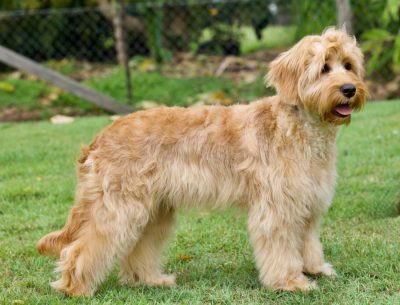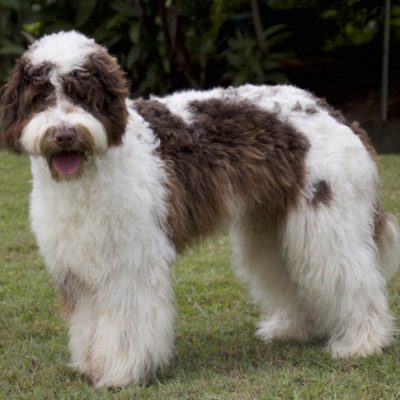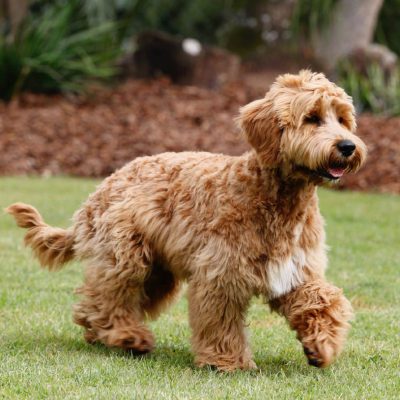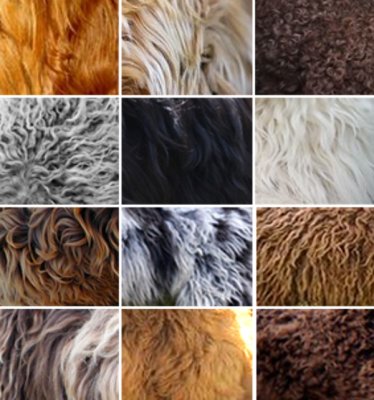Cobberdog Coats
See Grooming your Cobberdog Puppy's Coats here.
The coat of this beautiful dog is one of the features that make it such a special breed, and distinguish different lines of this breed.
Our Cobberdog coats are either FLEECE or WOOL. These different coat types have slightly different appearances.
Each coat type provides different benefits for the owners, so read on and find out more about these coat types, and how to look after them. Remember for both coat types, clipping every 8-10 weeks is recommended and regular grooming is important.
Regardless of the type of coat, every Australian Cobberdog shares the same positive personality traits for which they were specifically bred, these being gentle nature, intuition, intelligence, and deep connection with humans.
Fleece Coats
These coasts appear silky and very gently wavy. The fibres are like the angora goat fibres – silky fine and light to touch, light reflective and with a gorgeous soft sheen. The coat fibres gather and hang in soft clusters called staples, that fall in waves and swirls.
The fleece coat Cobberdog has very little shedding, so it is generally free of doggy odour, and allergy-friendly. The really great thing about fleece coats is that dirt falls out of the coat.
Fleece coats require grooming and clipping to be maintained free of tangles and matting, see Grooming below.
Fleece coats need clipping from time to time to keep the coat manageable, as the fibres keep growing.
Fleece Coat
Wool Coats
As we have progressed more to the breed standard, we don't get very many pure wool coats which are a bit coarser because the fibres are thicker, and more dense because the curls are tightly packed.
What we do get is the curly fleece which is still non-shedding, and hypo-allergenic. The spiral wool coat hangs in long loose spirals and looks beautiful. Because of the very little shedding, so there is no dander or doggy smell, and it is excellent for allergy sufferers. It has a DNA composition of one copy of straight and one copy of curly coat.
Usually there is very little difference between the look of this coat and a straight fleece coat. This coat requires a little more grooming and clipping to be maintained free of tangles and matting, see Grooming below..
Cobberdog Coat Colours
All the Cobberdog coats can be any of the colours. Coat colours are grouped into two colour sections - solid and shaded.
The solid group have an even colour all over. The colours are raven, chocolate, red, caramel, chalk and caramel ice.
The shaded group have a blend of colour tones. They are black, blue, blue merle, silver, gold, apricot cream, caramel cream, cafe, lavender, parchment and chocolate merle.
It is normal that all Cobberdog coats may show sun bleaching after prolonged exposure, which can lighten the colour.
Grooming Cobberdog Coats
BRUSHING
ALL the Cobberdog long coats must have a thorough brushing at least weekly to remove fallen hairs and keep the fibres from matting. If the coat matts and dreadlocks, the only solution is to clip them right off. The coat will grow back long in 3-6 months.
Brushing daily is even better if you want to maintain a matt-free shaggy look. Start brushing your puppy from the time it comes home, a little more often so that it becomes used to being brushed. Brushing time is a lovely connection and bonding time too, so your puppy will come to enjoy being groomed.
If the coat is kept clipped short, then you don’t need to brush them as often, so this is an easier option for some people.
TRIMMING
Clipping every 8-10 weeks is highly recommended. We also recommend keeping the hairs short around the face, ears and feet to help the dog to see clearly, make ear care easier, and keep the feet tidy. Keeping the hair on the pads trimmed will help prevent slipping on smooth surfaces like tiles.
Full or partial coat clipping can be done by a professional groomer, and can cost up to $90 for a medium dog. Coats that are regularly trimmed need to be done 5 to 6 times per year. Full or partial coat trimming can be done by the owner with clippers, and even with scissors.
See more details about caring for your Cobberdog's coat at Grooming your Cobberdog Puppy's Coat.
Do Cobberdogs shed their coats?
There should be little or low- shedding of Cobberdog coat fibre, with more or less depending on the type of coat - see below. What's more, the skin cells around the follicle do not shed which means the coat does not have a dog smell, and really has no specific smell at all.
Do Cobberdogs smell 'doggy'?
Cobberdog coats have no ‘doggy smell’ and are less- or non-allergenic. This is because they have little or low shedding or dander; read on to see how that works... Shedding is where hair falls from the coat loosening dead flaking skin cells called dander, which create that unpleasant doggy smell.
Are Cobberdogs allergy friendly?
It's the dander/dead skin cells that loosen from the dogs coat with shedding, and settle on surfaces or float in the air that irritate allergy sufferers! With very little or low shedding, the Cobberdog coat makes this breed a great choice for allergy sufferers. Wool coats are the lowest-shedding, and are the very best choice of Cobberdog for allergy sufferers.
In some cases, people allergic to dogs have ben found to be allergic to the saliva not the hair; it might be useful to check this out.
What is the Cobberdog coat fibre?
Cobberdog coats are not hair texture. Instead, the coat comprises natural fibre that has greater moisture content and light reflection than hair. This means that it feels silky and soft to touch, and has a shiny, fine, silky appearance. The coat fibres gather and hang in groups that are called staples.
What are the Cobberdog coat types?
The Australian Cobberdog coat description and characteristics were derived from the Angora goat!
We have two types of coats in our Australian Cobberdogs; fleece and wool. These different coat types have very slightly different appearances. Regardless of the type of coat, every Australian Cobberdog shares the same positive personality traits for which they were specifically bred, these being gentle nature, intuition, intelligence, and deep connection with humans.




